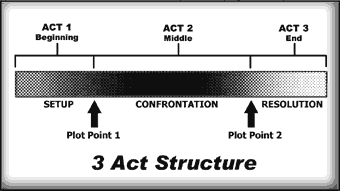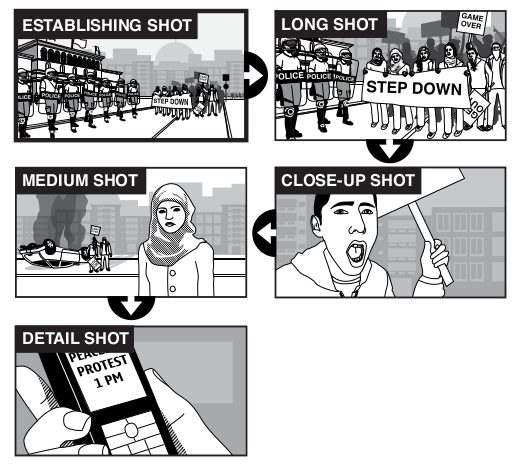Introduction to Video Editing
Video editing is the process and technique of working with video images to create a finished piece of video work. Understanding basic video making theory will help you know which technical elements of video editing to use.
When films were first shown there were no editing techniques. People marveled at simple scenes of workers in a factory with no cuts in the filming or music playing. Now cutting and sound editing are key to the language of modern films.
If you have been brought up as a child in an environment where you watched television or films then you already know some of the language of video. You will be amazed at the number of storytelling and visual storytelling techniques that you know intuitively.
Storytelling
To tell a story in your video, be it a news report, documentary or fictional work, it is advised to include answers to the following questions;
- Who is it about?
- What happened?
- When did it take place?
- Where did it take place?
- Why did it happen?
These are know as the Five Ws. You may also want to include How it happened as well.
Stories normally start by establishing where and when events are happening and who is involved. They then introduce the key reasons behind the story. Once interest is sparked, there is usually some kind of conflict, confrontation or drama which the storyteller (presenter or editor) will somehow try to resolve by the end of the story. The structure is shown in this diagram.1

While these beginning, middle and end sections are more obviously present in a feature film or longer documentary, they are usually present in all stories no matter how short they are. Part of the technique of editing is to squeeze all of these elements into a short report.
Resources for Storytelling
The Video for Change Curriculum from WITNESS and their Video Advocacy Toolkit both have excellent resources on Storytelling.2
The Our Video Toolkit looks at creating video as a group process and has some very effective and interesting resources and exercises to do this.3 It asks the following questions chapter by chapter; including
- What Do You Want to Communicate and Why?
- How Will Video Communicate Your Idea?
- How Will You Work as a Group?
There are also insights on how to structure your story, be it a documentary or a feature film.
Insight Share, have some fantastic exercises exploring the process of storytelling as a participatory process lead by the group rather than being dictated by a teacher. One of their key exercises is the Participatory Video Storyboard Technique.4
Visual Storytelling
To tell a story using video footage and video editing software we need to recreate the way that humans experience reality, but by using artificial techniques. Because our eyes and ears are so sensitive we can pick up many details of the scene in front of us and our mind can concentrate on the details it feels are most relevant. The same is true to a certain extent with spoken information, while we may receive information out of order, our brains work quickly to arrange them into a story that makes sense for us.
Visual Storytelling has techniques which allow video makers to recreate the process of assembling a story. This is done mainly through the use of different kinds of video shots, the choice of what is contained in them, and the order they are in.
Get your audience to read your film
Understanding modern techniques is essential for communicating with your audience. Watch lots of movies and examine how cuts are made. How do scenes end? What does a fade to black signify or a slow dissolve?
Create atmosphere
Editing styles can alter the feel of your film. Short snappy cuts give the film a tense, fast pace. Long clips and slow traditions between cuts allow time for the audience to relax into the scenes.
Use editing illusions
Clever editing can create illusions. Just the sound of a helicopter creates the illusion that there really is a helicopter just out of shot. Editing can also help smooth over problems. You can edit around a difficult interview by cutting out bits.
Use multiple camera angles
If you need to show more than one aspect of a scene, you can film the scene several times from different angles and cut between those angles during the editing process.
Explore the "montage" technique
Montage is the principle underlying all editing. The audience are trying to interpret your film as they watch and create meanings from the images and sounds as you play them. If, for example, you put together a politician’s speech without sound, followed by images of war, then the politician is assumed to be talking about war. Montage creates a new meaning from two independent images. You can lead the audience this way, for example, if you show separate images of two people walking down a street, the audience will assume the two will eventually meet.5
Resources on Visual Storytelling
In this guide we do not have the time to cover these issues fully but there are many great resources online about the story telling elements and techniques of video making. The following illustration shows different types of video shots is from Small World TV's guide to Safely and Securely Producing Media.6

Visual Storytelling builds on the technique of montage described above. At its best this kind of storytelling can use shared language and convention to effectively communicate a message. The down side is that it can create a very prescriptive, inflexible approach to making video.
Hands On: Logging Shot Types
Storytelling conventions are often most visible in humorous pastiches of genres. The over-used conventions of documentaries, adverts, entertainment shows and news reports have all been imitated for comic effect. These works can be very useful resources when learning or teaching the language of television and film. Search the Internet for "Charlie Brooker How to Report the News" to watch an example of different shot types used in a news report.
Now watch some news reports and documentaries. Make a list of what types of shots are used and in what order. How often are they used? What else is happening in the report? Is there a voice-over of a news reporter or narrator being used to accompany the video footage? Are graphics used to explain abstract ideas? When are close up shots used? Asking yourself questions like these and making notes to de-construct video reports will really help you when you start to construct these reports yourself with video editing software.
- http://en.flossmanuals.net/video-production/how-are-fictional-films-structured/^
- http://www.witness.org/how-to/curriculum/introduction-storytelling http://toolkit.witness.org/^
- http://en.flossmanuals.net/video-production^
- http://insightshare.org/resources/pv-handbook^
- Materials from Our Video Toolkit - Michael Wray http://en.flossmanuals.net/video-production/authour-credits/^
- http://smallworldnews.tv/guide/^





